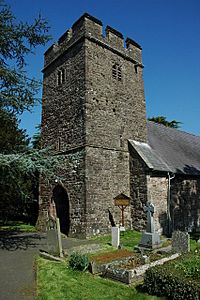St Cybi's Church, Llangybi, Monmouthshire facts for kids
Quick facts for kids St Cybi's Church, Llangybi, Monmouthshire |
|
|---|---|
| Church of St Cybi | |

The entrance and tower
|
|
| Lua error in Module:Location_map at line 420: attempt to index field 'wikibase' (a nil value). | |
| Location | Llangybi, Monmouthshire |
| Country | Wales |
| Denomination | Church in Wales |
| History | |
| Status | Parish church |
| Founded | C13th-C14th century |
| Architecture | |
| Functional status | Active |
| Heritage designation | Grade II* |
| Designated | 18 November 1980 |
| Architectural type | Church |
| Administration | |
| Parish | Llangybi |
| Deanery | Raglan/Usk |
| Archdeaconry | Monmouth |
| Diocese | Monmouth |
The Church of St Cybi is a historic church located in Llangybi, Monmouthshire, Wales. This beautiful church has been around for a very long time, with its first parts built in the 13th or 14th century. It was updated in the 15th century and then carefully restored again in 1909–1910.
Inside, the church has amazing medieval wall paintings. One special painting is called Christ of the Trades, which dates back to around 1460. St Cybi's Church is still an active church today. It is also a Grade II* listed building, which means it's a very important historical site. An expert on buildings, John Newman, once said it was "one of the most interesting" churches in the Usk Valley area.
Contents
History of St Cybi's Church
The church is named after St Cybi, a saint from the 6th century who came from Cornwall. People believe he was the one who first started a church here. The building you see today was constructed either in the 1200s or 1300s.
Restorations and Artworks
The church received updates in the early 1700s. Later, in the early 1900s, it was restored by an architect named W H Dashwood Caple. The old wall paintings inside are from the medieval period. These include a painting called The Creed and the famous Christ of the Trades. For many years, these paintings were covered with white paint. Now, they have been fully uncovered and restored as part of a big project to fix up the church.
Notable People and Events
Adam of Usk, a priest and writer from the 15th century, was in charge of this church in 1423.
The churchyard is also the site of a grave connected to a sad event from the 1800s. It holds the victims of a crime involving a Spanish sailor named Josef Garcia. He was found guilty of a terrible crime against five members of the Watkins family, who lived in the village.
Just outside the churchyard, you can find the remains of a Holy well. This well is also dedicated to St Cybi. Some experts believe that this well, along with the White Hart Inn in the village, might have been mentioned by the famous poet T.S. Eliot in his poem Usk. The lines from the poem say:
- "Do not suddenly break the branch, or
Hope to find The white hart behind the white well."*
Architecture and Design
The church building is designed in the Perpendicular style. This style was popular in England during the late medieval period. The West Tower has two levels and does not have any buttresses, which are supports often seen on old buildings.
Inside the Church
During recent renovations, the original medieval roof of the nave (the main part of the church) has been uncovered. An expert named Simon Jenkins praised the restoration of the church's interior in the early 1900s. He said it was "masterly" and credited W. D. Caröe for the work.
Besides the medieval wall paintings, the church also has some painted messages from the 1600s. There are also several monuments inside, including one for John Morgan from 1805. This monument shows a woman crying over an urn under a weeping willow tree.
The pulpit, where the preacher stands, was put together again in the 1700s. It has a special sounding board above it to help make the preacher's voice louder. The wooden benches, called pews, are from the 1800s. The organ, which has also been refurbished, was installed in 1933.

